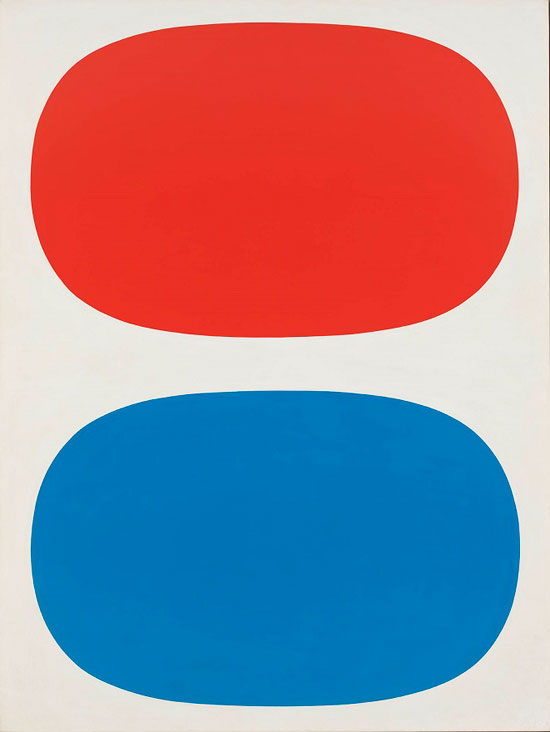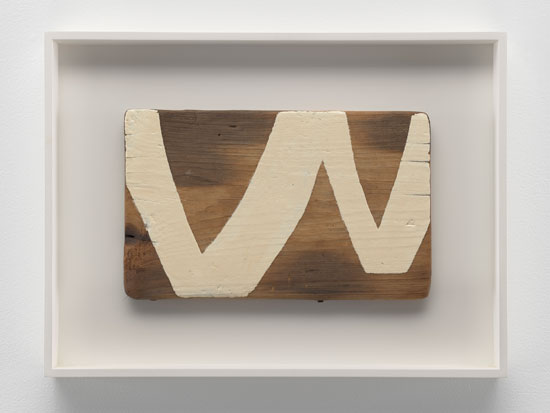When artist Ellsworth Kelly drove out to the East End for the first time in 1960, he was escaping the city in pursuit of a little quiet. Almost 60 years later, a focused and visually seductive exhibition at Guild Hall in East Hampton, NY, “Ellsworth Kelly in the Hamptons,” fills a historical gap by focusing on this sojourn as well as a second trip to the East End and the work he made during these times.
At age 37, when Kelly made his first trip to Springs, NY, located just outside of East Hampton Village, he was an established star in New York, having been included in “Sixteen Americans” at MoMA alongside his friend Jasper Johns and Frank Stella. In Springs, Kelly worked large on canvases was captured in a photography, including two of the highlights in the Guild Hall show. White Alice, 1960, has a freely brushed spontaneity that gives it a feeling of movement that is more kinetic than the tighter, flatter work for which he is best known. Its leg-like forms seem to stride the length of Wiborg Beach in East Hampton, NY.
.

"White Alice" by Ellsworth Kelly, 1960. Oil on canvas, 30 x 42 inches. Artwork: © Ellsworth Kelly Foundation. Image: Ron Amstutz, Courtesy Ellsworth Kelly Studio. Image courtesy Guild Hall.
.
The meticulous hard-edged paintings, monochromes as well as tri-colored and bi-colored works, are other highlights in the exhibition. The central wall of the Woodhouse Gallery, where the paintings are on view, is given over to the boisterous Red, White and Blue, made in 1961 and on loan from the Whitney Museum. It announces itself with all the subtlety of the brass section in a big band. I preferred, from the same year (and also shown in the same photo of the artist in Springs) Blue on White, 1961, which can be used to test one’s eye for color matching and memory. Only six steps from one to the other, the viewer can discern the difference between the blues, even if from a distance they look like a match.
.

"Red, White and Blue" by Ellsworth Kelly, 1961. Oil on linen, 88 1/4 x 66 9/16 inches. Whitney Museum of American Art, New York. Gift of Betty Parsons 70.1582 © Ellsworth Kelly. Courtesy Guild Hall.
.

"Blue on White" by Ellsworth Kelly, 1961. Oil on canvas, 85 5/8 x 67 3/4 inches. Smithsonian American Art Museum. Gift of S.C Johnson & Son, Inc.1969.47.63. Courtesy Guild Hall.
.
A terrific wall in the same gallery pairs a tapering pair of yellow and red panels, tightly locked together at the medial seam where their edges meet, Yellow/Red, 1968, with a Matisse-like collage of painted papers. The most absorbing painting in the room, Dark Blue White, 1960, delves a deeper blue, swirled and stroked with an unusual level of texture for Ellsworth Kelly. It rests on its white plane and viewing it compelled me to check to see that the blue is never quite tangent to the edge of the canvas, however temptingly near it may approach.
.

"Dark Blue White" by Ellsworth Kelly, 1960. Oil on canvas, 37 x 33 inches. Estate of Ellsworth Kelly, courtesy Matthew Marks Gallery. Image courtesy Guild Hall.
.
When Kelly returned to the East End in the summers of 1968 and 1969, he stayed in Bridgehampton, NY. Escaping the city heat and his apartment at the Hotel des Artistes on the Upper West Side in New York City, he became interested in the potato barns and architecture of the nearby farms. A group of his grainy, somewhat desolate photographs of barns is in the Guild Hall’s Spiga Gallery, interesting for their sloping geometries, which guest curator Phyllis Tuchman believes were visual stimuli for some of the well-known parallelograms in Kelly’s paintings of the period.
Posing the question and including the photographs is worthwhile, and useful for visitors’ understanding. Still, as with the legendary story of Kelly contemplating the windows rather than the art in the museums of Paris and capturing their open forms in drawings, a little of this kind of conjecture goes a long way.
The show stealers are three soft-spoken small chunks of driftwood or discarded construction wood on which Kelly applied a creamy white oil paint, using a curved geometric motif somewhere between the spoon-like shape of an oar and an elongated ellipse bound by the straight edge of the wood. Tucked together in a corner of the Moran Gallery, which is devoted to the drawings, these works have the understated elegance that sets Kelly apart even from his peers, including Robert Rauschenberg, Jasper Johns and Cy Twombly (who puts white to similar use in his sculpture).
.

"Untitled" by Ellsworth Kelly, 1960. Oil on Wood, 5 ¾ x 9 ¼ x ¾ inches. Private Collection. Courtesy Guild Hall.
.
Even as small as these pieces are, they take their place in the artist’s mastery of the shape, which I have enjoyed not just in the paintings but also in his sculpture. At the Fondation Beyeler in Switzerland, for instance, Kelly’s White Curves are the big brothers to these forms, although they were made four decades later in giant, freestanding aluminum.
Also in the Moran Gallery, a group of open line drawings of leaves and horseshoe crabs, like the line drawings of Matisse and Cocteau, reduce the natural world of the Hamptons to a few deft strokes of pen or pencil on paper. All would have been perfect, a word that comes to mind when viewing any Kelly show of this magnitude, except for a brief issue with ambience.
There were relatively few visitors to Guild Hall during my afternoon visit, in contrast to the hordes that had descended on the other end of East Hampton Village over Labor Day Weekend. Even so, the 2007 film made about Kelly’s work toward the end of his life (he died in 2015 at 92 years old) was playing to an audience of two young tourists at an unnecessarily high volume in the Spiga Gallery, adjacent to the gallery filled with the (visually) quietest works in the show: the drawings. The effect was to break the reverie accompanying my enjoyment of a spare drawing in green watercolor, Grass, 1961, a mere seven blades on a single stalk of grass.
.

"Grass" by Ellsworth Kelly, 1961. Watercolor on paper, 28 ½ x 22 /12 inches. Estate of Ellsworth Kelly, courtesy Matthew Marks Gallery. Image courtesy Guild Hall.
.
Any premise for an Ellsworth Kelly show is welcome and Tuchman had the cooperation of the prestigious Matthew Marks Gallery, the Whitney, and Jack Shear, Kelly’s longtime companion, as well as the backing of the Guild Hall curatorial team and board of trustees to ensure that the quality of the individual works was exceptional.
Kelly's visits to The Hamptons may have been just a couple of sabbaticals, a few cups of coffee with Roy Lichtenstein and James Rosenquist, and wistful recollections of Pollock and de Kooning along the back roads of East Hampton, but as the Guild Hall exhibition demonstrates, Kelly's time out east provided the inspiration and the impetus for enough art to add up to a lovely tribute to an American master.
_______________________________
BASIC FACTS: “Ellsworth Kelly in the Hamptons” is on view August 11 to October 8, 2018 at Guild Hall, 158 Main Street, East Hampton, NY 11937. www.guildhall.org
_______________________________
Copyright 2018 Hamptons Art Hub LLC. All rights reserved.
